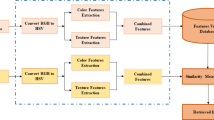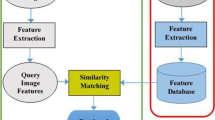Abstract
In this article, a fractal base method has been implemented as a texture descriptor. As, fractal deals with self-similarity, the proposed method is able to find the similarity of local patterns of various images of similar group and discriminate the images of dissimilar patterns. Images are converted to binary images by using the concept of local binary pattern. In this paper we have proposed a new approach for texture classification called Pixel Range Calculation (PRC) method, which has been implemented by converting the color images to gray images. Four benchmarking datasets, such as, ALOT (Amsterdam Library Of Textures), UMD (University of MarylanD), KTH-TIPS2b (Kungliga Tekniska Hogskolan-Textures under varying Illumination, Pose and Scale) and UIUC (University of Illinois at Urbana-Champaign) has been used for our experimental purpose. The proposed method along with two state of art method namely, Gliding Box Method (GBM) and Multi Fractal Spectrum (MFS) has been implemented and tested on the above-mentioned datasets. The experimental results based on the classification accuracy show the PRC technique of fractal dimension estimation method out performs the GBM and MFS. It has been observed that the computational complexity of PRC method is much less than other two state of art methods.














Similar content being viewed by others
References
Allain C, Cloitre M (1991) Characterizing the lacunarity of random and deterministic fractal sets. Phys Rev A 44:3552–3558. https://doi.org/10.1103/PhysRevA.44.3552
ALOT texture dataset (n.d.): https://aloi.science.uva.nl/public_alot/
Anantrasirichai N, Achim A, Morgan JE, Erchova I, Nicholson L (2013) SVM-based texture classification in Optical Coherence Tomography. In: 2013 IEEE 10th International Symposium on Biomedical Imaging. IEEE. pp. 1332–1335
Brodatz texture dataset (n.d.): SIPI Image Database - Textures (usc.edu). https://sipi.usc.edu/database/database.php?volume=textures
Bu X, Wu Y, Gao Z, Jia Y (2019) Deep convolutional network with locality and sparsity constraints for texture classification. Pattern Recogn 91:34–46. https://doi.org/10.1016/j.patcog.2019.02.003
Dash S, Senapati MR, Jena UR (2018) K-NN based automated reasoning using bilateral filter based texture descriptor for computing texture classification. Egypt Informatics J 19:133–144. https://doi.org/10.1016/j.eij.2018.01.003
Eichmann G, Kasparis T (1988) Topologically invariant texture descriptors. Comput Vision Graph Image Process 41:267–281. https://doi.org/10.1016/0734-189X(88)90102-8
Gagnepain JJ, Roques-Carmes C (1986) Fractal approach to two-dimensional and three-dimensional surface roughness. Wear 109:119–126. https://doi.org/10.1016/0043-1648(86)90257-7
Gupta Y, Lama RK, Lee S-W, Kwon G-R (2020) An MRI brain disease classification system using PDFB-CT and GLCM with kernel-SVM for medical decision support. Multimed Tools Appl 79:32195–32224. https://doi.org/10.1007/s11042-020-09676-x
Hall-Beyer M (2017) Practical guidelines for choosing GLCM textures to use in landscape classification tasks over a range of moderate spatial scales. Int J Remote Sens 38:1312–1338. https://doi.org/10.1080/01431161.2016.1278314
In Kim K, Jung K, Kim JH (2003) Texture-based approach for text detection in images using support vector machines and continuously adaptive mean shift algorithm. IEEE Trans Pattern Anal Mach Intell 25:1631–1639. https://doi.org/10.1109/TPAMI.2003.1251157
Ji H, Yang X, Ling H, Xu Y, Ji H, Yang X, Ling H, Xu Y (2013) Wavelet Domain Multifractal Analysis for Static and Dynamic Texture Classification. IEEE Trans Image Process 22:286–299. https://doi.org/10.1109/TIP.2012.2214040
Kang X, Xiang X, Li S, Benediktsson JA (2017) PCA-based edge-preserving features for hyperspectral image classification. IEEE Trans Geosci Remote Sens 55:7140–7151. https://doi.org/10.1109/TGRS.2017.2743102
Keller JM, Chen S, Crownover RM (1989) Texture description and segmentation through fractal geometry. Comput Vision Graph Image Process 45:150–166. https://doi.org/10.1016/0734-189X(89)90130-8
Khmag A, Ramli AR, Al-haddad SAR, Kamarudin N (2018) Natural image noise level estimation based on local statistics for blind noise reduction. Vis Comput 34:575–587. https://doi.org/10.1007/s00371-017-1362-0
Kim SC, Kang TJ (2007) Texture classification and segmentation using wavelet packet frame and Gaussian mixture model. Pattern Recogn 40:1207–1221. https://doi.org/10.1016/j.patcog.2006.09.012
Kirkby MJ (1983) The fractal geometry of nature. Benoit B. Mandelbrot. W. H. Freeman and co., San Francisco, 1982. No. of pages: 460. Price: £22.75 (hardback). Earth Surf Process Landf 8:406–406. https://doi.org/10.1002/esp.3290080415
KTH-TIPS texture dataset (n.d.). https://www.csc.kth.se/cvap/databases/kth-tips/download.html
Laine A, Fan J (1993) Texture classification by wavelet packet signatures. IEEE Trans Pattern Anal Mach Intell 15:1186–1191. https://doi.org/10.1109/34.244679
Liao S, Law MWK, Chung ACS (2009) Dominant local binary patterns for texture classification. IEEE Trans Image Process 18:1107–1118. https://doi.org/10.1109/TIP.2009.2015682
Liu X, Wang DL (2003) Texture classification using spectral histograms. IEEE Trans Image Process 12:661–670. https://doi.org/10.1109/TIP.2003.812327
Liu L, Fieguth P, Guo Y, Wang X, Pietikäinen M (2017) Local binary features for texture classification: taxonomy and experimental study. Pattern Recogn 62:135–160. https://doi.org/10.1016/j.patcog.2016.08.032
Liu C, Shao H, Wu M, Zhou Y, Shao Y, Wang X (2017) Multi-scale inherent variation features-based texture filtering. Vis Comput 33:769–778. https://doi.org/10.1007/s00371-017-1380-y
Liu L, Chen J, Fieguth P, Zhao G, Chellappa R, Pietikäinen M (2019) From BoW to CNN: two decades of texture representation for texture classification. Int J Comput Vis 127:74–109. https://doi.org/10.1007/s11263-018-1125-z
Liu L, Chen J, Zhao G, Fieguth P, Chen X, Pietikainen M (2019) Texture classification in extreme scale variations using GANet. IEEE Trans Image Process 28:3910–3922. https://doi.org/10.1109/TIP.2019.2903300
Ojala T, Pietikäinen M, Harwood D (1996) A comparative study of texture measures with classification based on feature distributions. Pattern Recogn 29:51–59. https://doi.org/10.1016/0031-3203(95)00067-4
Ojala T, Pietikäinen M, Mäenpää T (2000) Gray scale and rotation invariant texture classification with local binary patterns. In: Lecture Notes in Computer Science (including subseries Lecture Notes in Artificial Intelligence and Lecture Notes in Bioinformatics). Springer Verlag. pp. 404–420
Ojala T, Pietikainen M, Maenpaa T (2002) Multiresolution gray-scale and rotation invariant texture classification with local binary patterns. IEEE Trans Pattern Anal Mach Intell 24:971–987. https://doi.org/10.1109/TPAMI.2002.1017623
Qian X, Hua X-S, Chen P, Ke L (2011) PLBP: an effective local binary patterns texture descriptor with pyramid representation. Pattern Recogn 44:2502–2515. https://doi.org/10.1016/j.patcog.2011.03.029
Quan Y, Xu Y, Sun Y (2014) A distinct and compact texture descriptor. Image Vis Comput 32:250–259. https://doi.org/10.1016/j.imavis.2014.02.004
Quan Y, Xu Y, Sun Y, Luo Y (2014) Lacunarity analysis on image patterns for texture classification. In: Proceedings of the IEEE Computer Society Conference on Computer Vision and Pattern Recognition. IEEE Computer Society. pp. 160–167
Quan Y, Sun Y, Xu Y (2017) Spatiotemporal lacunarity spectrum for dynamic texture classification. Comput Vis Image Underst 165:85–96. https://doi.org/10.1016/j.cviu.2017.10.008
Raju P, Rao VM, Rao BP (2019) Optimal GLCM combined FCM segmentation algorithm for detection of kidney cysts and tumor. Multimed Tools Appl 78:18419–18441. https://doi.org/10.1007/s11042-018-7145-4
Ranganath A, Mishra J (2017) New Approach for Estimating Fractal Dimension of Both Gary and Color Images. In: 2017 IEEE 7th International Advance Computing Conference (IACC). IEEE. pp. 678–683
Ranganath A, Senapati MR, Sahu PK (2020) Estimating the fractal dimension of images using pixel range calculation technique. Vis Comput 37:635–650. https://doi.org/10.1007/s00371-020-01829-1
Sarkar N, Chaudhuri BB (1994) An efficient differential box-counting approach to compute fractal dimension of image. IEEE Trans Syst Man Cybern 24:115–120. https://doi.org/10.1109/21.259692
UIUC texture dataset (n.d.): http://www-cvr.ai.uiuc.edu/ponce_grp/data/index.htm
UMD texture dataset (n.d.): http://users.umiacs.umd.edu/~fer/website-texture/texture.htm
Varma M, Zisserman A (2002) Classifying images of materials: achieving viewpoint and illumination Independence. In: Proceedings of the 7th European Conference on Computer Vision, May 2002, Copenhagen, Denmark
Wang J, Fan Y, Li Z, Lei T (2019) Texture classification using multi-resolution global and local Gabor features in pyramid space. Signal Image Video Process 13:163–170. https://doi.org/10.1007/s11760-018-1341-6
Xing Z, Jia H (2020) An improved thermal exchange optimization based GLCM for multi-level image segmentation. Multimed Tools Appl 79:12007–12040. https://doi.org/10.1007/s11042-019-08566-1
Xu Y, Yang X, Ling H, Ji H (2010) A new texture descriptor using multifractal analysis in multi-orientation wavelet pyramid. In: 2010 IEEE Computer Society Conference on Computer Vision and Pattern Recognition. IEEE pp. 161–168
Xu Y, Quan Y, Ling H, Ji H (2011) Dynamic texture classification using dynamic fractal analysis. In: Proceedings of the IEEE International Conference on Computer Vision. pp. 1219–1226
Yong Xu, Hui Ji, Fermuller C (2006) A projective invariant for textures. In: 2006 IEEE Computer Society Conference on Computer Vision and Pattern Recognition (CVPR'06), pp 1932–1939. https://doi.org/10.1109/CVPR.2006.38
Zhao X, Lin Y, Liu L, Heikkila J, Zheng W (2019) Dynamic texture classification using unsupervised 3D filter learning and local binary encoding. IEEE Trans Multimed 21:1694–1708. https://doi.org/10.1109/TMM.2018.2890362
Acknowledgements
The authors acknowledge the support given by Veer Surendra Sai University of Technology, India under TEQIP-III.
Author information
Authors and Affiliations
Corresponding author
Ethics declarations
Conflict of interest
The authors declare that they have no conflict of interest.
Additional information
Publisher’s note
Springer Nature remains neutral with regard to jurisdictional claims in published maps and institutional affiliations.
Rights and permissions
About this article
Cite this article
Ranganath, A., Senapati, M.R. & Sahu, P.K. A novel pixel range calculation technique for texture classification. Multimed Tools Appl 81, 17639–17667 (2022). https://doi.org/10.1007/s11042-022-12186-7
Received:
Revised:
Accepted:
Published:
Issue Date:
DOI: https://doi.org/10.1007/s11042-022-12186-7




